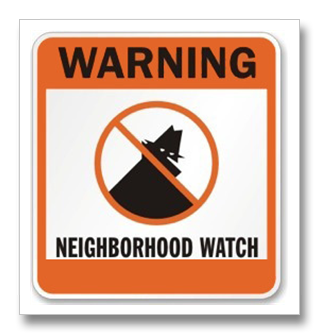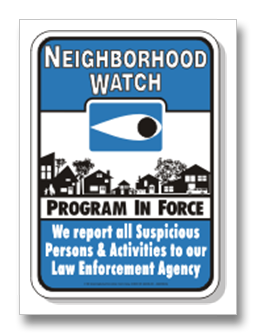Let us first start with the basics. What is a Neighborhood Watch?
Neighborhood Watch is a crime prevention program that stresses education and common sense among people. It teaches citizens how to help themselves by identifying and reporting suspicious activity in their neighborhood. It also gives residents the opportunity to give back to their neighborhood by working together to make the neighborhood safer and improve the quality of life.
Neighborhood Watch program first started in 1960 after the murder of a woman in New York. Watch groups then formed and the idea spread across the US.
Starting a neighborhood watch program is an effective, proactive way to fight crime and protect your home, family, and possessions. Neighbors who join forces to monitor activity in their area typically experience a lower rate of crime and a higher instance of convictions when crimes do occur. By working together with police and other law enforcement officials, communities with neighborhood watch programs create a safer, more closely-knit place to live for families in their area. Starting a new watch program is easier than you may think; police departments often have programs in place to help communities institute such programs more easily. The goal behind a neighborhood watch program is to organize a neighborhood so that people look out for each other and keep their eyes open for signs of criminal activity.
A well-run community watch program in your neighborhood can be far more effective than any police force in both stopping crime and maintaining privacy. Uniting a community under a common goal can turn neighbors into friends, making the area warmer and safer for everyone.
Just the presence of a neighborhood watch group in a suburban or rural area can often be enough to deter burglars or abductors from targeting the area. A neighborhood watch in city areas can help reduce crime rate by keeping the streets clear, making it safer for children to walk the sidewalks. It doesn't take much to get started; however the most important step (and perhaps the most difficult one as well) is to start a Community Watch or Neighborhood Watch program. Starting a Neighborhood Watch program in your neighborhood is not hard, but it will take a little time and some proper planning. Read on to see how you can organize and start a neighborhood watch in your area.
Step One - Getting started:
- Visit the National Neighborhood Watch Institute or USA On Watch
 to get great information to help you get started.
to get great information to help you get started. - Determine the area you want to organize. This should be the area you consider your neighborhood. Groups can range in size from 5 to 150 households. The larger the area, the greater the protection.
- Organize Neighbors From Your Street - Hold a meeting with the neighbors on your street to discuss the idea of starting a neighborhood watch, and find out who would be interested in signing up to volunteer. These people will form your core group of Neighborhood Watch Volunteers. The more neighbors you can get to participate, the better. You can even see if neighbors from nearby streets would be willing to participate in a larger neighborhood watch program, where the entire development or community can exchange information and tips to keep a larger portion of your area safe.
- Set up a free neighborhood watch website to help coordinate and communicate your efforts. Communication is the cornerstone of the Neighborhood Watch Program.
- Contact the local law enforcement (such as Sheriff's Office or Police Department) to register your community watch program and to schedule a meeting with a police or sheriff representative. Generally, the police department will assign a crime prevention officer to serve as a liaison to your group. This officer will help you organize your neighborhood, advise you on the best methods and practices for meetings and activities, and take any reports generated by your neighborhood watch program once it is in place.
- Distribute the invitations at least 2 weeks prior to the meeting. The most effective way to do this is to ask the Neighborhood Watch Volunteers to hand-carry them to neighbors and ask if they will attend. Get names and phone numbers if possible to make reminder calls later. Personal contact is usually the best. By meeting your neighbors directly, you can explain the benefits and purposes of a neighborhood watch and attract more participants.
- Your meetings can be located at a nearby school, church, community center, or simply in your own home, depending on your preference and available facilities.
- Make sure your crime prevention officer will be in attendance at this first meeting; he or she can give valuable information and advice that will help your neighborhood watch group fulfill its purpose.
- Discuss the concerns specific to your community at your meetings.
- Select an overall Program Coordinator.
- Create an online group such as at Google Groups or Yahoo Groups or Windows Live Groups to register the core members and to invite new members to the program. The online group will enable constant communication and exchange of information within the community.
- You can use the sign-up/registration process to gather important contact information such as emergency phone number, email address etc.
- Besides the Coordinator, typically, neighborhood watch groups also have a Block Captain who is responsible for distributing information to the Watch Volunteers and Members who are the eyes and ears of the organization on a day-to-day basis.
- Establish a communication network (Phone Tree), along with a plan of action in case of incident.
- Make the program goals of both safety and privacy policy known as soon as possible. Note of caution - A community watch program itself can turn into a type of privacy violation. Identify boundaries in clear terms, and explain exactly what you feel would be a violation of your privacy, thereby avoiding misunderstanding.
- Order neighborhood/community watch signs from the National Neighborhood Watch Institute
- Post the neighborhood/community watch signs at conspicuous locations warning would-be criminals that this neighborhood is protected and monitored and that you report any suspicious or criminal activity to local law enforcement agencies. Sometimes, a Neighborhood Watch sign is all you need to keep predators and intruders off your street and out of your neighborhood. Once your Neighborhood Watch program is established, there is certain amount of maintenance required for smooth and continuous operation.
- After your neighborhood has been organized, maintaining interest in Neighborhood Watch is important. It's too easy for us to forget to keep that vigilance we thought was so important in the beginning.
- Regular Meetings - In a typical program, meetings are held on a regular basis to discuss public safety issues and to provide information about what to do in various situations. Some groups maintain interest by planning neighborhood outings, meetings, summer picnics and passing out a Neighborhood Watch Newsletter every month. At least one yearly meeting is recommended, along with regular information distribution via online groups or printed fliers to keep residents up to date on neighborhood issues like reports of thefts, vandalism, and other recurrent issues.
- Communicate With Local Law Enforcement: Keep in regular touch with law enforcement about suspected and known criminal activity going on in the area.
 If you share the information you learn through your neighborhood watch with law enforcement, not only will they be grateful for the assistance, they'll be more likely to come by and share information with you, as well. Making friends with the local police department can certainly benefit your neighborhood watch, and the neighborhood as a whole.
If you share the information you learn through your neighborhood watch with law enforcement, not only will they be grateful for the assistance, they'll be more likely to come by and share information with you, as well. Making friends with the local police department can certainly benefit your neighborhood watch, and the neighborhood as a whole.
You can also set up regular meetings with local law enforcement to trade notes, share information, and come up with new ideas on how to combat issues within your neighborhood and your town. Contact your local police department's non-emergency number (not 9-1-1!), to ask about setting up a meeting with the police department and your local neighborhood watch. - Training: Prepare and conduct a training program for the volunteers and new members. Put forth a concerted effort to incorporate privacy maintenance into your training. Learn to identify and confront suspicious people and behavior.
Step Two - Contact your Local Law Enforcement
Step Three - Invite your neighbors:
Step Four - Get Organized:
Step Five - Install Neighborhood Watch signs:
Maintenance:
Finally, neighborhood crime prevention is only effective if the residents are active. Citizens need to be comfortable with calling law enforcement to report problems, ranging from emergencies to chronic issues like illegal parking. Neighbors should also get to know one another, and consider setting up a buddy system which promotes neighborhood bonds. For example, buddies can call each other when they are going out of town, to ask neighbors to keep a close eye on their homes.
theFundooGeek recommended reading :
- National Crime Prevention Council
- National Neighborhood Watch Institute
- USA on Watch
- A Checklist For Starting a Neighborhood Watch Program



 Newer Post
Newer Post
 Home
Home







Comments :
0 comments to “How to Start a Community/Neighborhood Watch Program”
Post a Comment